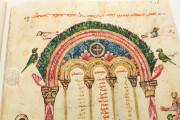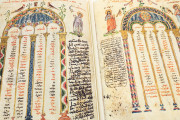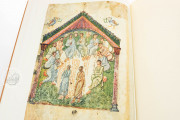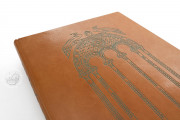Dated to 586 by the monk responsible for its main text, the Rabbula Gospels is a compilation of different elements that offer a glimpse into manuscript production and circulation in the eastern Mediterranean basin. The manuscript's gradual creation, annotation, and movement through different monastic communities demonstrate the high esteem enjoyed by this precious Syriac book over centuries.
The Rabbula Gospels comprises three sections that were gathered together over time. Preceding the Gospels, twenty-six illustrated parchment pages contain miniatures and canon tables and are immediately followed by paper leaves bearing liturgical readings written in the twelfth century. The third unit of the codex is the parchment section dedicated to the Peshitta (a Syriac word meaning simple or common) translation of the Gospels, which was completed by the monk Rabbula in 586.
New Interpretative Possibilities
The prefatory miniatures and illustrated Eusebian tables (fols. 1r-12v) are followed by full-page miniatures (fols. 13r-14v). While the illustrations were previously celebrated for offering a direct view into sixth-century illumination, it is now clear that these miniatures were not only subject to major overpainting but were likely also created for another book, probably an illustrated New Testament. The evidence of trimming on these leaves shows that this initial gathering was refit to the Rabbula Gospels after its original copying, probably in the second half of the fifteenth century.
Signed by Rabbula
The colophon (fols. 291v-292v) provides important evidence to support the argument that the miniatures were added to the codex. The dedication informs the reader that the manuscript was completed in 586 at the Monastery of Saint John in Beth Zagna—between Antioch and Damascus—and lacks any mention of the illustrations at the front. The text further identifies the scribe, Rabbula. While Rabbula penned the text of the colophon in a smaller size script than the main Gospel text, the script is nonetheless the same Estrangela, thus securely binding his dated signature to the Gospels.
Wanderings of the Late Antique Gospel Book
While the patron and destination of the book remain unknown, notes found in the Rabbula Gospels chart its movement over centuries. Small notes accompanying particular lections are often written in Serto, a version of Syriac script. The codex also has several notes in Syriac, Arabic, and Garshuni (Arabic transliterated into the Syriac alphabet), a testimony to the linguistic richness of the eastern Mediterranean.
The three portions that came to make the Rabbula Gospels traveled around modern-day Syria and Lebanon until the fifteenth century. An inscription reveals that the Gospels were given to the Church of Saint George in the eleventh or twelfth century following the death of Romano, a "priest and visitor from Antioch" (fol. 292v). This might have been the time when the readings written on paper were added to the codex. A note dated May 15, 1361, places the Gospels in the monastery of Qannubin Lebanon.
The first fourteen leaves containing the miniatures and illustrated canon tables were probably joined to Rabbula's text sometime around 1461/1462. The illustrated leaves bear inscriptions in various languages, and one is dated to the Greek year of 1772 (1460-1461 CE). The Garshuni inscription states that two priests—Gergis and Hallal of the Monastery of Hawqa— donated a "fascicle" to the Maronite Monastery of Santa Maria di Quannubin, thus perhaps revealing the combination of the scriptural section of the book to the renowned illustrations.
Presented by the Maronite Patriarch to the Laurentian Library in Florence, the Rabbula Gospels arrived in its new home around 1573. The codex was rebound shortly after its arrival, and it was likely at this time that some repainting was carried out.
We have 1 facsimile edition of the manuscript "Rabbula Gospels": The Rabbula Gospels facsimile edition, published by Urs Graf, 1959
Request Info / Price


















